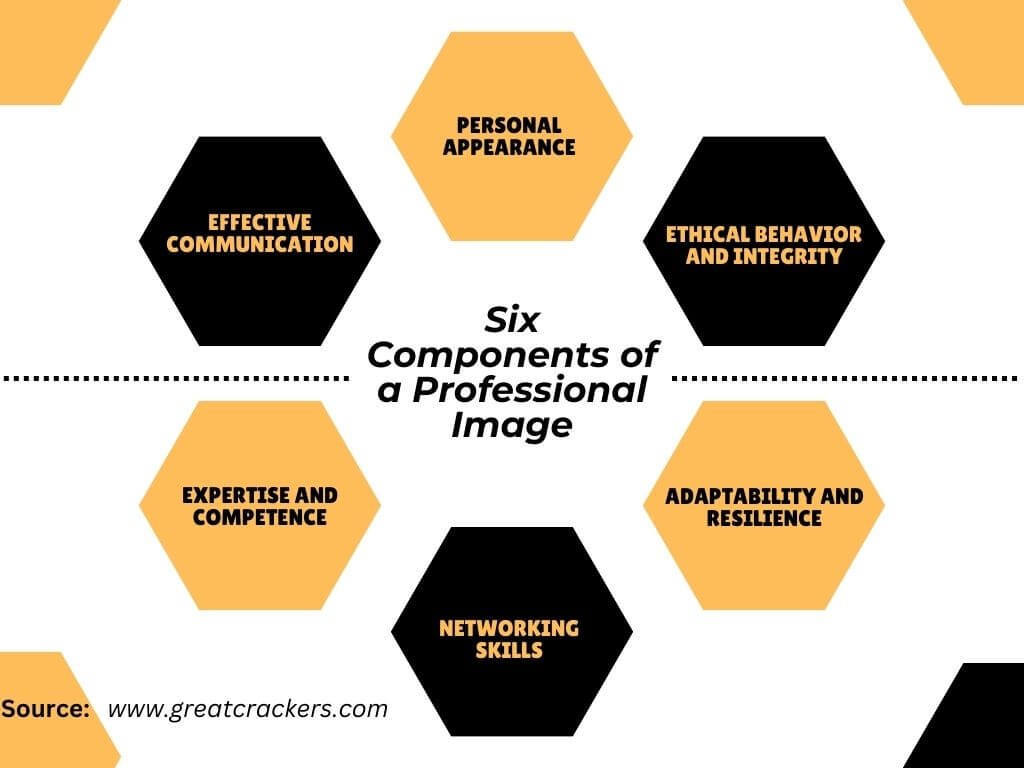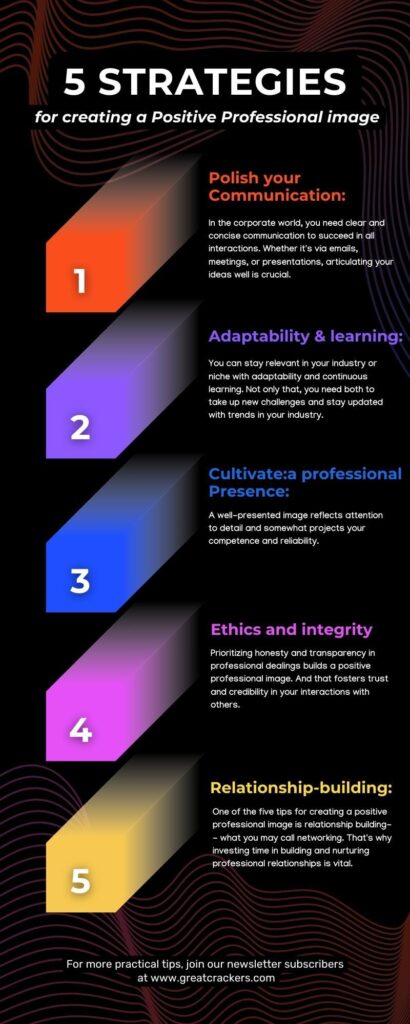How to Develop Your Professional Image (Learn 5 Practical Tips)
You might have asked yourself lately how to develop your professional image in the workplace. The truth? You’re only one out of many on the quest to realize success in your career journey.
Nothing less, nothing more. Hence, in this guide, you’ll learn everything you need to know to build a compelling presence in your workplace.
Ready to discover 5 practical tips for making a lasting impression in your professional career?
Stay with me.
First,
What is a Professional image?
In plain language, a professional image is how people see and perceive you or your organization in the workplace. Essentially, it’s about how you look, act, communicate, and show your expertise.
To that end, a professional image could be on an individual or corporate level. (You’ll learn more under the subheading type of professional image)
Projecting a positive professional image in your career builds credibility and trust with clients, colleagues, and superiors at a company. You make others see you as competent, reliable, and credible.
To achieve that, you should follow ethical standards, display your skills, and be genuine in how you present yourself to others. Whether you’re interacting with colleagues, stakeholders, or customers. However, when you and your team represent your company to others, you project an image —either professional or unprofessional.
For instance, imagine a scenario where two employees have the same level of expertise. One always dresses well in the office, communicates well, and behaves with courtesy. The other, however, is often disheveled, communicates, and behaves in an unprofessional way.
Of course, in this cited case, you don’t need anyone to tell you the first employee would have a better professional image at work. And more often than not, that leads to more trust and opportunities in the workplace.
What is a Professional Image in the Workplace?
In the workplace, projecting a professional image isn’t much different from industry to industry. It entails showcasing your competence, demeanor, and values within the organizational context.
However, professional image in the workplace goes beyond your appearance. Of course, it covers subjects like ethical conduct, effective communication, and problem-solving skills. So when you and your team cultivate a positive one, you boost unity, trust among colleagues, and leadership effectiveness.
Components of a Professional Image
Creating a strong professional image requires a careful balance of various components. Each of these elements works together to create an authentic representation. Below are the elements that allow you to build a well-rounded professional image:
1. Personal appearance
One crucial component of professional image is personal appearance. However, it extends beyond attire to include grooming, posture, and presentation. For instance, as a professional who dresses well, you convey a sense of self-respect and garner respect from peers and clients.
2. Effective communication
Effective communication skills constitute another integral element of professional image. Strong verbal and written communication skills are vital when building a professional image. This includes active listening ability.
Good communication skills allow you to clearly express your ideas in presentations. They also help you respond thoughtfully to questions and write clear emails.
3. Expertise and competence
These twins are foundational to a strong professional image. Often, it involves staying abreast of industry trends. But then also entails developing skills, and showcasing proficiency in tasks.
For example, an IT specialist can show competence by resolving complex technical issues. And that involves establishing a reputation as a reliable professional.

4. Ethical behavior and integrity
Maintaining ethical behavior and integrity builds the ethical foundation of a professional image. Upholding moral principles, being transparent, and demonstrating honesty build trust.
For example, when a financial advisor puts client interests before personal gain, it builds a reputation for integrity. Not only that, it forms lasting client relationships. In other words, ethical behavior and integrity are an extremely important element of your professional image.
5. Adaptability and resilience
Adaptability and resilience are like close siblings. They’re components of a professional image that you need to face challenges. Simply put, being able to handle change, learn from setbacks, and stay resilient adds to a positive professional image.
Let me give you a practical example. When there’s a shift in work demands, as a professional, you exhibit adaptability by adjusting your approach. Doing so can earn you admiration from others for your strategic skills.
6. Networking skills
Networking skills are also another of professional image. It emphasizes the importance of building and maintaining professional relationships.
You can do that by attending industry events and engaging on professional platforms. Of course, all these nurture connections that contribute to a robust network for you.
Five Tips for creating a Positive Professional image
Crafting a positive professional image is instrumental in career success. Here are five effective tips to create a positive professional image that connects well with others in your work life:
1. Polish your Communication
In the corporate world, you need clear and concise communication to succeed in all interactions. Whether it’s via emails, meetings, or presentations, articulating your ideas well is crucial.
Achieving that depends on active listening to others, which, in turn, fosters a culture of open and respectful dialogue. And when you get good at this, you enhance your reputation as a proficient and approachable professional.
2. Become adaptable and a Continuous learner
Being adaptable is a vital element of a professional image, yet one of the five tips for cultivating a positive one.
You can stay relevant in your industry or niche with adaptability and continuous learning. Not only that, you need both to take up new challenges and stay updated with trends in your industry. On top of that, they help you pursue opportunities for professional development.
3. Cultivate a professional Presence
In creating a professional image, you need a polished and professional appearance. That’s why you should let your dress stay consistent with your industry’s norms, paying attention to grooming and attire.
A well-presented image reflects attention to detail and somewhat projects your competence and reliability.
4. Uphold a strong sense of ethics and integrity
Prioritizing honesty and transparency in professional dealings builds a positive professional image. And that fosters trust and credibility in your interactions with others. In other words, a reputation for ethical conduct builds trust with colleagues, clients, and stakeholders.
5. Get good at relationship-building
One of the five tips for creating a positive professional image is relationship building—what you may call networking. That’s why investing time in building and nurturing professional relationships is vital.
You can attend industry events, engage on professional platforms, and seek mentorship opportunities. According to Corporate Wellness Magazine, attending industry conferences isn’t only for networking; it’s crucial for advancing your wellness career.

Why is Professional Image Important?
A strong professional image is crucial in today’s workplace for various reasons. Thus, this section will explain why the professional image is important in the workplace to you.
That said, here is why it is essential to maintain a professional image in the workplace as a career professional:
1. Project competence and reliability
Firstly, the professional image portrays a visual and behavioral representation of an individual’s competence and reliability. That’s why your colleagues, clients, and superiors often form initial impressions based on appearances and conduct.
That said, a positive professional image is a critical asset in establishing trust.
2. Boost Career advancement
Secondly, a strong professional image contributes significantly to career advancement. Individuals with a polished and consistent image are more likely to be considered for leadership roles and key responsibilities.
That’s because a person’s positive professional image conveys his competence and ability to represent his organization effectively.
3. Increase Chances of employment
Thirdly, in a competitive job market, a favorable professional image can be a decisive factor in securing employment opportunities. That’s because requisite skills are not what employers are looking for in candidates. Instead, they’re looking for those competencies that align with the company’s values.
In other words, a well-crafted professional image sets candidates apart, making them more appealing to potential employers.
4. Support teamwork and collaboration at the workplace
A positive professional image fosters workplace relationships and collaboration. Colleagues are more inclined to engage with individuals who exude professionalism. And that ultimately encourages a positive and cohesive work environment.
That said, effective communication, ethical behavior, and a commitment to continuous improvement—all elements of a professional image—contribute to a harmonious workplace culture.
5. Career and business success
In client-oriented industries, a positive professional image directly contributes to business success. Clients are more likely to trust and engage with professionals who project a polished and credible image. This, in turn, facilitates successful client relationships, repeat business and positive word-of-mouth referrals.
Types of Professional Image
A professional image involves many aspects that shape how others see you at work. Various types exist, yet each has unique attributes. However, successful professionals create their professional image by combining elements from different categories.
To do this, they first understand industry expectations and carefully shape an image that matches their brand and career goals. That said, below are types of professional image:
1. Corporate Professional Image
This type of professional image emphasizes alignment with the organizational culture and values. Professionals projecting a corporate image adhere closely to established norms and expectations of their industry and company.
While dress code, communication style, and behavior reflect the corporate identity, they foster a cohesive organizational image.
For instance, a tech employee may choose a casual dress code and use informal language. More often than not, the reason for that is that he’s mirroring his company’s innovative and laid-back culture.
2. Entrepreneurial Professional Image
Entrepreneurs are known for traits like innovation, risk-taking, and proactiveness, and they build a unique professional image around these qualities. And often, this shapes their distinct identity.
Thus, this entrepreneurial professional image emphasizes individuality, creativity, and a willingness to challenge conventional norms. When you lead with vision and position yourselves as forward-thinkers and trailblazers, you project this distinctive and influential image.
3. Technical Professional Image
The technical professional image aims to establish credibility based on specialized knowledge and competence. It emphasizes technical skills, problem-solving abilities, and a commitment to staying abreast of technological advancements.
For example, technical and engineering professionals often emphasize their expertise and proficiency to project a strong and confident professional image.
4. Service-Oriented Professional Image
This professional image emphasizes interpersonal skills, a customer-centric approach, and a commitment to delivering high-quality service.
That’s why service-oriented professionals like healthcare or customer service providers aim to build trust and rapport with clients and stakeholders. Because this image centered on empathy, communication, and client satisfaction.
5. Leadership Professional Image
Regardless of industry, leaders cultivate an image focused on vision, decisiveness, and the ability to inspire and guide others. That’s because this professional image type emphasizes strategic thinking, effective communication, and a strong ethical foundation.
Thus, building a leadership professional image instills confidence and influence within the organization and the broader professional community. This results in career growth and success as a professional.
What are the 4 main attributes of a professional image?
The construction of a robust professional image is rooted in four key attributes. Each plays a pivotal role in shaping how individuals perceive you or others in a professional context:
1. Competence
At the core of a professional image lies the attribute of competence. Being good at your job, keeping up with industry trends, and always getting better make people see you as capable and skilled.
Hence, highlighting competence through education, certifications, or a proven track record is essential to building a positive professional image.
2. Reliability
Reliability is a cornerstone attribute that underscores trustworthiness and dependability. When you show consistency in delivering high-quality work, meeting deadlines, and fulfilling commitments, it contributes to a reputation for reliability.
Of course, this attribute is crucial in building trust among colleagues, superiors, and clients. In short, it forms the foundation of a positive professional image.
3. Professionalism
When you talk about professionalism, it covers a range of behaviors and characteristics, including ethical conduct and effective communication. Also, part of the list is a polished appearance.
That said, adhering to ethics, being respectful and collaborative, and aligning with industry expectations build a positive professional image. However, professionalism is not only about what one knows but also about how one conducts oneself in the workplace.
4. Adaptability
Adapting to changing circumstances and evolving environments is crucial in today’s dynamic professional landscape. It highlights the importance of flexibility, openness to new ideas, and proactiveness in approach.
Professionals who welcome change, show resilience in challenges and demonstrate a willingness to learn project an adaptable image.
FAQ on Professional Image
What is the best way to project a professional image?
The best way to project a professional image is by taking essential traits like reliability, appropriate dressing, effective communication, etc. That said, don’t forget that consistency, professionalism, and a positive attitude contribute to a strong and favorable professional image.
What are the characteristics of a positive professional image?
A positive professional image is characterized by reliability, appropriate dress, effective communication, expertise, consistency, professionalism, and a positive attitude. These traits help you to develop a strong and favorable impression in the professional arena.
Final Thoughts
We’ve looked at the definition of professional image, what it means in a workplace, the different types, and its components. And more essentially, you’ve learned the five tips for creating a positive professional image at work and beyond.
It’s time to start building a strong professional image that provides all the opportunities you need to achieve your career goals.







